| Reviews & Columns |
|
Reviews DVD TV on DVD Blu-ray 4K UHD International DVDs In Theaters Reviews by Studio Video Games Features Collector Series DVDs Easter Egg Database Interviews DVD Talk Radio Feature Articles Columns Anime Talk DVD Savant Horror DVDs The M.O.D. Squad Art House HD Talk Silent DVD
|
DVD Talk Forum |
|
|
| Resources |
|
DVD Price Search Customer Service #'s RCE Info Links |
|
Columns
|
|
|
Tales of the Gold Monkey: The Complete Series
Fun and charming and light...despite a season-end turn towards weightier matters. Shout! Factory has released Tales of the Gold Monkey: The Complete Series, a six-disc, 21-episode set that resurrects the fondly-remembered 1982 series from syndication oblivion. Starring Stephen Collins, Jeff McKay, Caitlin O'Heaney, Roddy McDowall and of course, Tales's best-remembered cast member, Leo the Dog as one-eyed terrier Jack, Tales of the Gold Monkey apparently has a small but rabid cult following on the internet now, so this release--complete with some nice extras like episode commentaries and a "making of" documentary--should be the answer to those fans' prayers.
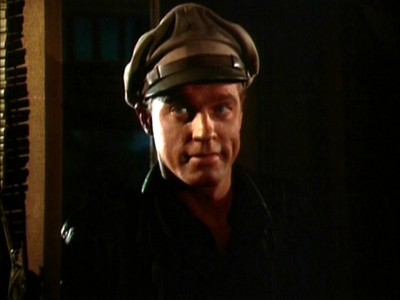
1938, somewhere in the South Pacific. High above the clouds, ex-Flying Tiger airman-turned-adventurer Jake Cutter (Stephen Collins), cigar stump firmly clenched in his teeth, pilots his rickety Grumman Goose amphibious seaplane--dubbed Cutter's Goose--over the tiny islands of the Marivellas chain, looking to land at his home base: Boragora Island. Jake's constant co-pilot, Jack, a one-eyed terrier who understands English, isn't found of take-offs and landings, so he usually can be found curled up on a cushion in the back cargo hold, balefully glaring at Jake with his one good eye. Skimming the water and docking the Goose at the small harbor, Jake invariably makes his way to the Monkey Bar, a fabulous watering hole of bamboo and carved mahogany, owned by Boragora's French Magistrate, 'Bon Chance' Louie (Roddy McDowall), a seen-it-all cosmopolitan plunked down in the middle of this primitive island paradise. As regular a fixture at the Monkey as the carved primates that decorate the place, drunken, forgetful mechanic and Jake's best friend, Corky (Jeff MacKay), will no doubt be propping up the bar when Jake busts in. Over by the piano, scrapper Sarah Stickney White (Caitlin O'Heaney) supposedly stranded on Boragora and singing for her supper at the Monkey, is in actuality an espionage agent working for the American government. She's a pretty little thing, and she has it bad for Jake (likewise for the pilot), but she's loathe to admit she likes the charming rogue. Also keeping an eye on the comings and goings of the active Japanese military in the area is good-natured, bumbling German Nazi agent Willy (John Calvin), who, like Sarah, has adopted a cover for his covert activities: he's posing as Reverend Willie Tenboom, a Dutch missionary who "blesses" all the pretty, naïve native girls. Not so bumbling--in fact, quite cunning and deadly--is Jake's sometimes nemesis/sometimes ally, Koji (Marta DuBois), a beautiful, deadly (and let's face it: stacked) Japanese 'Dragon Lady' princess who runs Matuka Island with ruthless authority and who engages in all manner of illegal smuggling and trade.
SPOILERS ALERT!
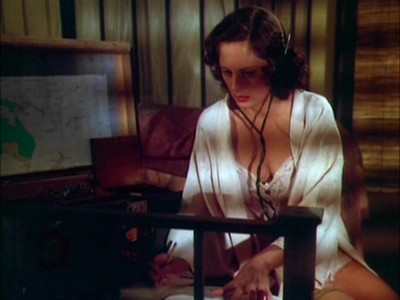
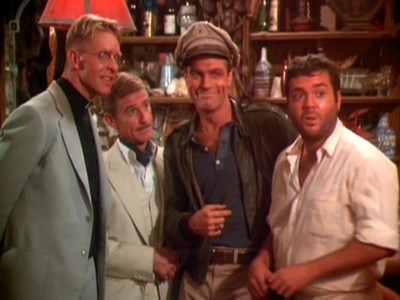
I would imagine the few regular readers I have left would assume a title like Tales of the Gold Monkey would inspire me to write a book about its virtues (or drawbacks) since Tales' nostalgic tone and now-vintage status (almost thirty years ago since its debut) provide a double-whammy of interest for my favorite type of TV reviewing. I won't go on and on, though, about Tales of the Gold Monkey (is that cheering?), not because it isn't a good series, or an awful one, but because it's simply a fun, pleasant excursion...and that's it. That isn't damning Tales of the Gold Monkey with faint praise; I enjoyed re-visiting the Monkey Bar and laughing at Corky's drunken forgetfulness and Jack's snide "Woof!" for "No," and "Woof Woof!" for "Yes." But I was continually surprised (and maybe a little disappointed) at how disposable and inconsequential it all felt throughout its 21 episodes--even when the producer, Donald P. Bellisario, of Magnum, P.I. and Quantum Leap fame, so obviously tried to change the show's direction mid-season towards more meaningful, mysterious romance and drama. That judgment will probably bring down on me the wrath of the Gold Monkey cultists, but if I can live through The Fugitive and Shirley Temple goons, I can write, unafraid, that Tales of the Gold Monkey is a sweet, fun show and nothing more.
Certainly if you were a regular TV watcher back in 1982, you at least heard about not only Tales of the Gold Monkey but also Bring 'Em Back Alive!, CBS' effort to cash in on the Raiders of the Lost Ark success the previous year. There was a lot of hype about both expensive shows trying to recapture the glory days of the Saturday afternoon serials, and even though everyone connected with Tales of the Gold Monkey stresses endlessly that their show had nothing to do with Raiders (hmm...not very much), it's clear that the networks saw both shows that way, and right or wrong, so too were the TV audiences directed. I caught Tales of the Gold Monkey on a semi-regular basis back in '82, admittedly tuning out towards the end of the show's run when it changed to a more serious tone (and when it switched nights and went up against Falcon Crest). Prior to getting this set, I had fond but vague memories of the show (the dog and the plane...and Roddy McDowall, for some reason, stuck out most in my mind), sentiments shared by a few other viewers, apparently, from that time period (when it was listed as one of my upcoming reviews, I received some reader emails--even one from a fellow DVDTalk reviewer--wondering if the show was going to "hold up" to their childhood memories). However, since I hadn't watched the show since I was a kid, and it's never been a strong presence in syndication (too few episodes), this Tales of the Gold Monkey DVD set may have well been a new viewing experience for me.
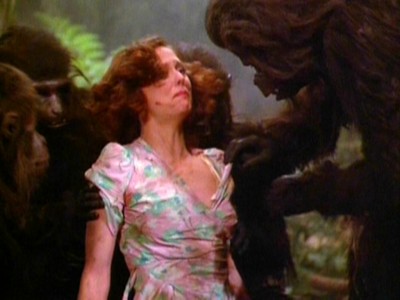
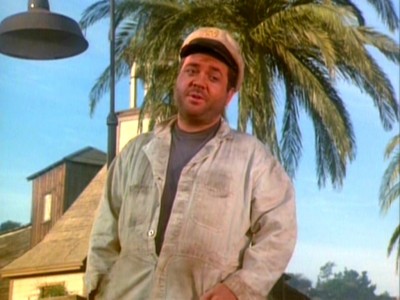
That said, it's not hard to see that most of Tales of the Gold Monkey is derivative as all get-out. It seems a very fine point to put on the series to continually stress it's not a Raiders rip-off, when its premise obviously borrows from a myriad of other sources, from the Terry and the Pirates comic strip, and Hawks' Only Angels Have Wings, to Casablanca, the original King Kong, King Solomon's Mines, The Devil at 4 O'Clock, and countless other "B" serials, South Seas adventure and WWII films clocking in for good measure. Even individual episodes have more specific references, such as Ape Boy playing like an ersatz Tarzan; The Lady and the Tiger echoing Angel and the Badman, Force of Habit channeling Heaven Knows, Mr. Allison, and Last Chance Louie borrowing elements of Dickens' A Tale of Two Cities. Just to be clear: there's nothing wrong with being derivative, even though that word usually has negative connotations. After all, genre work derives much of its pleasures from repeated motifs and structures. But it works against the series to see so many references--both visual and thematic--reworked with results that don't come close to matching the original inspirations.
Of course, as a kid in 1982 (or more accurately, a teen), I didn't care if Tales of the Gold Monkey borrowed liberally from Hollywood's treasure chest of adventure/romance/action elements. I was probably just looking for something fun and exciting on a boring Wednesday school night. And particularly during its initial episodes, Tales of the Gold Monkey delivers on that excitement (albeit excitement in 1982 television terms, which translates into slower, more tempoed action when compared with the peripatetic violence on today's TVs), giving us cartoonish, serial matinee fodder such as machete duels, French penal colony atrocities, a bar fight in almost every episode, Japanese Zero attacks, perilous rope bridge escapes, Watsui blow-gun assaults, the Goose crash-landing every other episode, and huge attacking apes (not once but twice), with the added bonus of them sexually pawing at Sarah, playing like something right off the cover of one of those 1950s men's adventure magazines. And all of that is quite fun and bouncy, even allowing for Tales' TV budget trying for Spielberg kineticism (even though Tales of the Gold Monkey was one of the costliest TV shows at that time--with episodes frequently going over-budget--its production design falters when it comes time for the special effects, which still look charmingly cut-rate). It may not be Raiders, but it certainly bests other earlier adventure fare like Sergeant Preston of the Yukon or ABC's previous hit, Tarzan, in the action department.
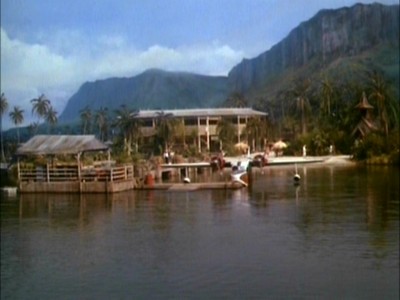
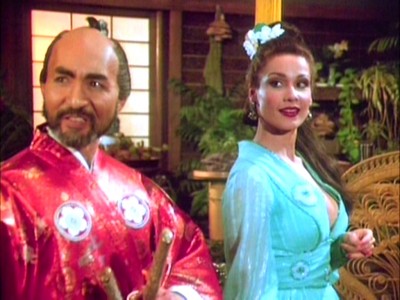
Tales is smart, too, in its calculations, keeping things light and breezy while avoiding any potential controversies that might arise for 1982 sensibilities. In its 1982 pre-P.C. infancy, characters are always careful to mention the good qualities of Japanese culture whenever Jake finishes off a Japanese soldier, while Nazis are portrayed as bumbling fools right out of Hogan's Heroes (the Reverend Willie character is utterly eviscerated after the first one or two outings; we often forget he's a spy...since they never show him spying). Jake isn't a Flying Tiger anymore, so no one has to get into the whole China/Japanese conflict. And indigenous people are treated with a modicum of respect...whenever they're not throwing spears at our fleeing heroes. Indeed, the most villainous character in the series doesn't represent a state or a particular ideology; Princess Koji is 'Dragon Lady' simple, stopping her insatiable quest for more money and power only long enough to get into Jake's pants (when the uh...gifted DuBois turned sideways, a number of old teen fantasies came back with stunning clarity). As for our leads, they banter with low-grade Hawksian jibes about romance and sex and jobs that come before both of those pleasures, with few if any annoying contextual signposts, and for the most part, Collins and O'Heaney pull those scenes off with more polish and sparkle than they really deserve. At first glance, one might be tempted to think Collins too pretty boy clean-cut to pull off a rough-and-tumble two-fisted American adventurer (sort of like Harrison Ford's younger, more polite brother). But once you get the rhythm of the show down, he's perfect for this TV incarnation of the old Saturday afternoon adventure serial precisely because he's too impossible perfect and square and cartoony-handsome: he's the very approximation of the true-blue, pre-cynical 50s pop culture TV/comic book hero, perfectly homogenized for impressionable youths out there (and that's not a slam against Collins--that's a tough row to hoe to make it funny and believable). O'Heaney is even better, coming off like one of Hawks' gum-snapping, tough-talking adventure dames...by way of one of Hawks' screwball comedy vixens. She really gets the mixture of spoof, comedy, and action that makes up the first half of this season. It's just a pity that the writers almost immediately abandon her character (we see her spy like...twice) in favor of bringing in other women for Jake to romance.
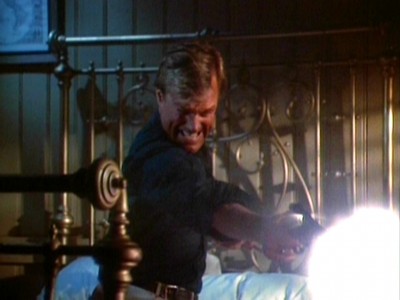
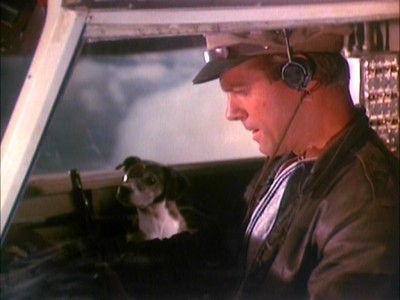
Equally adept at mining genre conventions for audience-expected pleasures are the talented supporting cast members. Roddy McDowall, always a favorite, is a big improvement over Oscar-winner Ron Moody who originated the role of 'Bon Chance' Louie in the pilot, bringing along some needed fantasy adventure cache to his role (no small consequence back in '82, when the Planet of the Apes film series was still considered right up there with Star Wars in the sci-fi genre). Inhabiting a role that isn't too far removed from Claude Rains' turn in Casablanca, McDowall's Louie is all friend and no foe, but he's so good at it that you don't mind that the writers hadn't yet explored any possibilities of having Louie turn on Jake and Sarah. The recently passed MacKay is TV-perfect as the bumbling sidekick Corky, looking like something out of an Abbott & Costello or Bowery Boys romp, with his sweet, forgetful, slightly inebriated, ever-cheerful chubby face and perpetually puzzled expression making an indelible impression on the viewer. As for the real star of Tales of the Gold Monkey Leo the Dog proves that old Hollywood adage: if you're an adult actor, don't work with kids or animals, because they'll steal the spotlight time and again. Being such a cute little bugger aside, Leo's timing (regardless of editing) is impeccable, and the gag of having Jack understand English while barking "yes" and "no" answers to his humans' seemingly impossible-to-understand questions, works every single time. Clearly the writers knew a good thing when they had it, featuring Jack prominently in episode after episode, elaborating his gags for more and more effect (I'm not sure what's funnier: his mixed-up barking when he's conked on the head, or a Japanese subtitle when he barks, presumably in the same language, to a pursuing Japanese assassin).
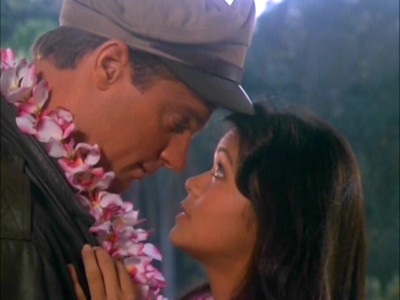
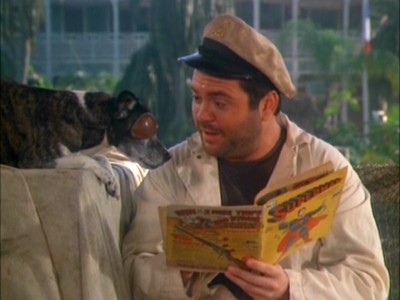
All of this is funny, light, and charming...which brings us to the format change. One doesn't need to hear it from head writer and producer Tom Greene on the episode commentaries that something changed with Tales of the Gold Monkey about half-way through: the switch in tone is immediately noticeable...and frankly not any more or less successful than the earlier broad, bantering atmosphere. According to everyone involved, series creator and producer Donald P. Bellisario was unhappy with ABC's insistence on a Raiders clone, and disliked the fact that he couldn't find writers who shared his vision of the show. He didn't want "mud people and monkeys," according to Greene. He wanted more of Casablanca and Only Angels Have Wings. Fine. But watching the remaining episodes of the season, I didn't find them any more intrinsically worthwhile than the earlier, sillier shows. It's obvious there's a sniffing, dismissive tone leveled by Greene (and apparently others involved in the production) at those earlier romps, with the latter character-driven episodes favored as the "right" way to go with the series (Greene believes his own Last Chance Louie episode should have been the template for the series; I personally thought The Lady and the Tiger, written by Bellisario, was the series' best, combining action and comedy with drama, along with a delightfully bizarre subplot of Amish settlers on an Asian island (?) and a Japanese officer infatuated with American cowboy pictures--that was a magical, mixed-up story that made me sit up and take notice). Watching these more serious, somber efforts today, I was reminded why I tuned out from the series back in '82 (I was a kid; I wanted something light and fun, not heavy and romantic). So one would think I'd respond more positively to these episodes now that I've matured a bit. Well...one would think. However, I didn't find these episodes any more or less "original" or "meaningful" or "adult" than I found the earlier ones "original" or "exciting" or "playful." They were just as derivative as the first episodes--just from different sources. No offense to Greene, who's understandably proud of his work here, but I didn't find them "classics" or "masterfully" acted and written and directed, as he enthuses about them. They're enjoyable in different ways than the first episodes, and they're produced well enough for 1982 television, but they're not especially memorable or original in their dramatic themes or dialogue. They're...fine, for what they are. No more or less, and certainly not inherently "better" than their predecessors just because they aim for what the writer and the producer evidently thought was a "higher purpose." If these later episodes were closer to Bellisario's original vision, fine. But they resound with the same slight impact as the earlier, funnier, lighter episodes. If Greene is right in his commentaries, stating that audiences were increasing due to this change, that's interesting...but it's still no indication that Tales of the Gold Monkey would have been a lock for success in a second season. The Nielsen's told a different story.
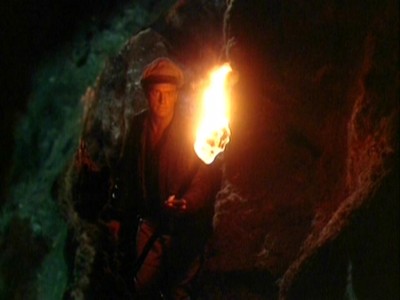
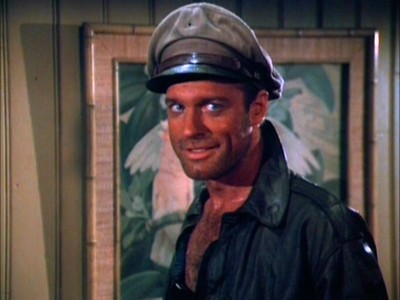
According to the hype I remember, ABC put a lot of time and money into this series, promoting it as one of their potential new big hits back when the network was fighting CBS for the number one spot in the ratings. Unfortunately, Tales of the Gold Monkey failed to crack the coveted Nielsen Top Thirty at the end of the 1982-1983 season (even with a reported uptick in viewers towards the end when they writers largely jettisoned the juvenile tone), and ended its run as a one-off footnote, fondly remembered only by the kids who remembered Jack and Jake and Corky and the Cutter's Goose. Given a more-than-optimal time slot at 8:00pm (while the kiddies were still up) on Wednesday nights, Tales of the Gold Monkey couldn't have asked for better lead-outs, including 9 o'clock's The Fall Guy (rising to an impressive 14th for the year over its previous showing of 26th), and at 10, Dynasty, which jumped 14 slots to be the fifth most-watched show of 1982. Tales of the Gold Monkey didn't have any serious competition over on CBS, with its ill-conceived contemporary updating of Seven Brides for Seven Brothers; however, Tales couldn't shake the weakening but still lingering popularity of NBC's once-hefty Real People, which managed to scrape by in its penultimate season with a 29th slot in the year-end overalls. With the handwriting probably already on the wall for the underperforming Tales of the Gold Monkey (although O'Heaney claims Bellisario was offered a second season and turned it down), a timeslot switch in March to Friday nights at 10:00pm was attempted--a disastrous move against ratings' killer Falcon Crest on CBS (8th overall for the year). By April, the show was over, with some repeats burned off during June and July of 1983...to no avail. Cutter's Goose sailed off into the sunset for the last time.
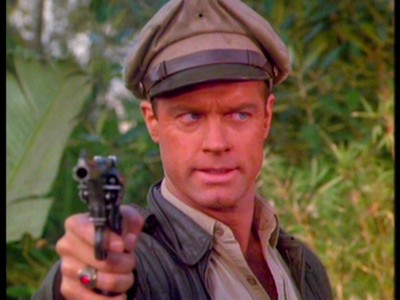
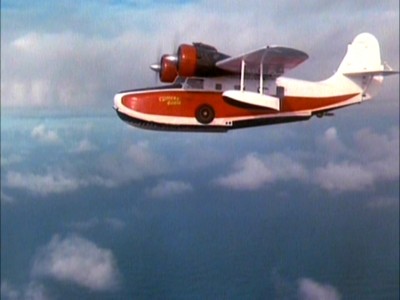
Here are the 21 episodes (including the original pilot movie) of the six-disc set, Tales of the Gold Monkey: The Complete Series, as described in the set's beautifully designed episode guide:
DISC ONE
Episode 1 - Tales of the Gold Monkey (Pilot Feature)
High-flying adventurer Jake Cutter and his feisty one-eyed dog, Jack, plunge into danger on a fiery volcanic island where ferocious man-sized monkeys guard a coveted giant golden idol when a sabotaged seaplane and a captivating American woman agent draw Jake into a death-defying race with a murderous German spy and a cunning South Seas princess.
Episode 2 - Shanghaied
Jake and Sarah undertake a rescue mission plagued by attacking Japanese Zeros and the fever of malaria when, with Jack as the only witness, Corky is shanghaied as part of a diabolical plot to enslave an innocent tribe of mud people.
Episode 3 - Black Pearl
Jake Cutter reluctantly agrees to pose as a defecting American scientist with a penchant for swordplay to infiltrate a mysterious island encampment where the Germans are conducting an ominous military experiment.
DISC TWO
Episode 4 - Legends Are Forever
Jake, Corky and Jack brave a treacherous landing and a fierce tribe of tiny warriors when a brawling old flying buddy of Jake's and a majestic Watusi chieftain persuade them to undertake a perilous mercy mission.
Episode 5 - Escape From Death Island
Not even Louie can free Jake and Corky from a hellish French prison after they join a desperate father's abortive attempt to smuggle his dying son from the island penal colony.
Episode 6 - Trunk From the Past
Jake delivers a hieroglyphic-covered trunk that unleashes ghostly visions of Sarah's late father and his bizarre murderer--an ominous god of ancient Egypt--and her estranged fiancé arrives on the Clipper determined to complete her father's search for a pharaoh's cursed tomb.
Episode 7 - Once A Tiger...
Jake races to an island inhabited by dangerous natives and a ravenous swamp creature to save an old Flying Tigers buddy and beat the Japanese to a downed plane carrying a revolutionary new gunsight.
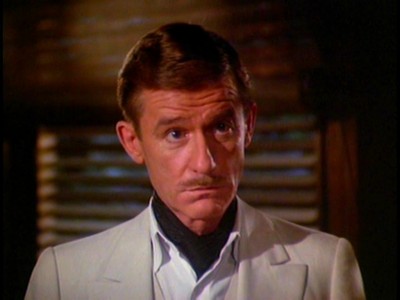
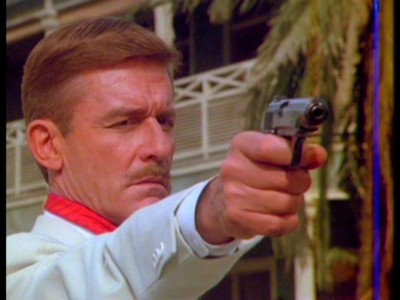
DISC THREE
Episode 8 - Honor Thy Brother
Jake is mystified by several harrowing brushes with death, Sarah is on the trail of a suspicious Japanese bomber, a brawling German sailor turns up with Jack's eye, and Corky unexpectedly lands a bride.
Episode 9 - The Lady and The Tiger
Jake is challenged to an old-fashioned shoot-out when he attempts to protect a lovely Amish widow and her son from a gun-slinging Japanese soldier and a man-killing tiger.
Episode 10 - The Late Sarah White
Stunned by reports of Sarah's death, Jake and Corky risk a flight to Manila, where Sarah's trail leads to an unexpected rendezvous with Gen. Douglas MacArthur.
Episode 11 - The Sultan of Swat
Jake goes to bat for an idolized baseball player who becomes the object of a manhunt after an island girl is murdered and her father seeks vengeance outside the law.
DISC FOUR
Episode 12 - Ape Boy
Jake, Sarah, Corky, and Jack discover a boy raised by apes in a remote jungle, and soon become locked in battle with his fiercely protective ape parents and three trappers who are backed by Princess Koji's samurai army.
Episode 13 - God Save The Queen
Jake enlists the aid of a stunning duchess and her celebrated uncle--the Duke of Windsor--when a disgruntled English lord hides a powerful bomb aboard an ocean liner to force delivery of the royal jewels.
Episode 14 - High Stakes Lady
Jake flies a beautiful card shark to a high-priced poker game on Tagataya, but when the stakes include a smuggled roll of film, he learns the lady is gambling with his life.
Episode 15 - Force of Habit
Jake and his friends are shocked when a young lady who will soon take her vows as a nun--and happens to be an old pal of his--hijacks the Goose to track down a stolen shipment of cholera vaccine.
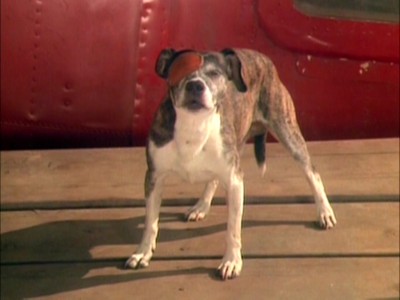
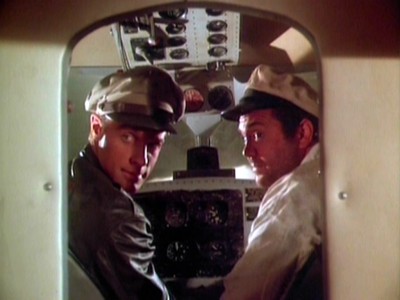
DISC FIVE
Episode 16 - The Cooked Goose
Jake charms Princess Koji into helping him pursue her own deadly mercenaries after they demand a $500,000 ransom for a Clipper pilot's new bride, and Corky decides to leave Boragora forever after the Goose goes up in flames while he sleeps it off nearby.
Episode 17 - Last Chance Louie
When Louie is convicted of murder, Jake and the victim's embittered daughter fly to battle-torn Saigon to seek the shocking secrets that may save Louie from the guillotine.
Episode 18 - Naka Jima Kill
Jake, Corky, Jack and Sarah land in the midst of a plot to assassinate a top Japanese official when a beautiful but unscrupulous newsreel reporter tricks Jake into flying her to Princess Koji's island.
Episode 19 - Boragora Or Bust
Boragora becomes a bawdy boomtown after a prospector friend of Jake's discovers platinum, but the old man's life is endangered when an arrogant city slicker jumps his claim.
DISC SIX
Episode 20 - A Distant Shout of Thunder
While Jake stages a daring evacuation of Boragora, Sarah is targeted for ritual sacrifice by a rabble-rousing revolutionary after the island is mysteriously plagued by fire, frogs, blood, an earthquake, and a devastating volcanic eruption.
Episode 21 - Mourning Becomes Matuka
Jake's life hangs in jeopardy as he poises on the brink of self-execution in an attempt to flush out Princess Koji's would-be assassin.
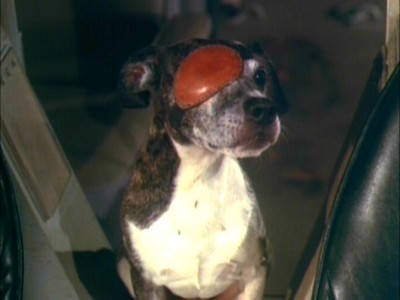
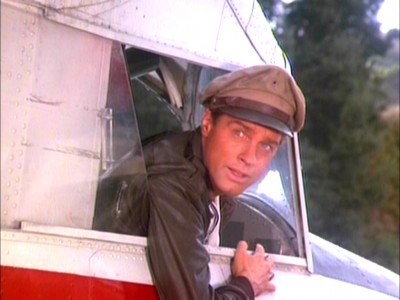
The DVDs:
The Video:
The full-frame, 1.33:1 video transfer for Tales of the Gold Monkey: The Complete Series hasn't been restored or "boosted," looking more like a typical Shout! release of a vintage title than say, a Paramount restoration. Colors are a tad faded and muddy at times, contrast can be overdone a bit, while scratches and anomalies are noticeable at times but no distracting. An acceptable but not overwhelming transfer of a show that looked amazing when it first aired.
The Audio:
The Dolby Digital English 2.0 stereo mix is adequate but not overwhelming, with a moderate recording level and noticeable but not distracting hiss. Subtitles or close-captions, unfortunately, were not available.
The Extras:
Five audio commentaries by head writer/producer Tom Greene are included on Force of Habit, Last Chance Louie, Naka Jima Kill, Boragora Or Bust and A Distant Shout of Thunder, providing a wealth of information on the writing and production process of the series. I didn't agree with Greene's effusive assessment of the second half of the season, but that's understandable: I didn't write it. He's an entertaining host, though. The other major bonus is a Making Of... documentary on the series, running a healthy 36:19, featuring interviews (from September of 2009) with Collins, O'Heaney, Greene, and director Harvey Laidman. It, too, offers quite a bit of background on the series, along with some insight as to why the show may have been canceled. A Series Synopsis and Series Concept are just original network text that appear in the gorgeously designed (and copiously detailed) episode guidebook, while text Character Biographies and Personal Biographies give some added context to the characters and performers. A Facts File and Stills Gallery round out the impressive extras for this one-season series.
Final Thoughts:
Reading this back, I guess I did write a book. I might be alone among the Tales of the Gold Monkey cultists when I state the "improved" mature tenor of the later-season episodes didn't improve this homage/spoof of high-flying serials and action-packed Hollywood romance adventures at all--it just made it different. Light, funny, charming, and then more serious and romantic, Tales of the Gold Monkey is enjoyable but ultimately disposable television...and that's not a bad thing at all if you're looking to while away some time in front of the tube. I recommend Tales of the Gold Monkey: The Complete Series.
Paul Mavis is an internationally published film and television historian, a member of the Online Film Critics Society, and the author of The Espionage Filmography .


|
| Popular Reviews |
| Sponsored Links |
|
|
| Sponsored Links |
|
|
| Release List | Reviews | Shop | Newsletter | Forum | DVD Giveaways | Blu-Ray | Advertise |
|
Copyright 2024 DVDTalk.com All Rights Reserved. Legal Info, Privacy Policy, Terms of Use,
Manage Preferences,
Your Privacy Choices | |||||||












